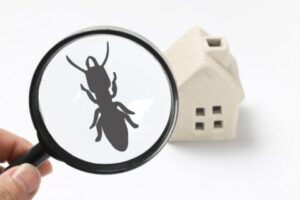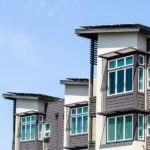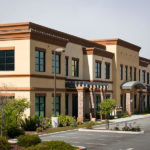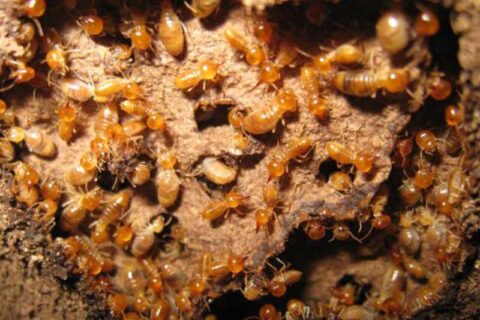How to Identify Termites
What do termites look like? Do you know? Many people don’t but knowing how to identify termites is important if you are a homeowner. Identifying termites on sight can alert you to the fact that you have a termite infestation in your home, and need to call for termite control. Here, we offer a helpful guide to identifying termites and telling them apart from similar-looking insects.

Let’s start with what a termite looks like. Termites are very small, ranging from one-eighth of an inch to one inch long, with kings and queens being the largest termites in a colony. They can be brown, black, or white, and their appearance varies based on their species, as well as their role in the colony. Termite colonies have several castes, and each caste performs a certain task to keep the colony running smoothly. The appearance of the different types of termites depends on their species, but they all have six legs, two straight antennae, and soft, segmented bodies. There are over 40 species of termites in the United States, but in the Bay Area, subterranean, dampwood, and drywood are the most common.
Subterranean termites range from pale cream to dark brown or black. The most common species of termites infesting houses in the United States, they nest in the soil, underground. They must have moisture to survive, so you’re unlikely to see them. What you’re more likely to notice are the mud tubes that allow them to travel from the ground into your home without exposing themselves to dry outside air. If you do see them, however, you will notice differences between the appearance of members of different castes.
- Workers have soft, pale bodies. These are the termites who search for food, tend to the larvae, and perform maintenance on the nest. They build the tunnels, gather the food, and distribute it to the other termites in the colonies. When needed, worker termites can become soldiers.
- Soldiers have larger, darker heads than workers. They also have large jaws, called mandibles, which are used to defend the colony. These mandibles allow them to do their job, battling insects (usually ants) that attack or invade the colony. However, the mandibles are not good for chewing, so worker termites have to feed them. There are not very many soldiers in a termite colony, which is why worker termites sometimes evolve into soldiers, to help them fight off an attack.
- Reproductive termites include the king, queen, and alates. The king and queen are larger than other termites in the colony, and the queen is much larger than the king, with a very enlarged abdomen. You’re not likely to see the king and queen, because they remain underground in the nest, since their only job is to reproduce. Alates are young reproductive termites, and they are easy to tell apart from other termites because they are the only termites with wings. Alates fly away from the colony in search of a mate, and when they find one, they drop their wings and become kings and queens of new colonies.
Dampwood termites are the largest termites in North America, but they have the smallest colonies. Like Subterranean termites, they need moisture, but unlike Subterranean termites, they do not build mud tubes. Instead, they nest in the damp wood they infest, typically rotting timber. However, they can also infest buildings with high moisture from plumbing leaks, poor ventilation, or drainage issues, or old gutters filled with leaves. Once they’ve tunneled into a piece of wood, they plug the hole behind them with fecal matter. They’re typically brown but can be light or dark, and sometimes even reddish.
- Dampwood workers are larger than Subterranean workers. They have cream-colored bodies and darker heads.
- Dampwood soldiers look ferocious. Nearly an inch long, they have large, flat heads with dangerous-looking mandibles.
- Dampwood alates have two front wings and two rear wings. These wings are equal in size and shape.
Drywood termites, like Dampwood termites, live inside the wood. Often found in humid, coastal areas, they get the moisture they need to survive from the humidity in the air or from the wood in which they live. Their colonies are much smaller than Subterranean termites, and they don’t live underground. This means they can be found in different places in your home. They don’t need mud tubes, so that’s not a sign of their presence. You’re more likely to notice piles of termite feces, called frass. Drywood termites eat both with and across the grain of the wood, and can feed on harder layers than other termites. They are quite voracious, and it’s not unusual to see them in trees and fences as well as in the home’s wooden structure.
- Drywood worker termites are cream to white. In this way, they resemble Subterranean termites.
- Drywood soldiers are much larger than Subterranean soldiers. They have dark, orangish-brown heads and opaque bodies.
- Drywood alates have amber-colored heads. Their abdomens are dark brown, and their wings are a smoky gray.
Of course, it is unlikely that you will see termites, even if you have a termite infestation. It’s more likely that you will see signs of their activity, like discarded wings, mud tubes on the outside of your home, or piles of frass near tiny holes. These are all signs that it’s time to call for termite treatment.
Sometimes, other insects are mistaken for termites. This happens quite frequently with carpenter ants, which, like reproductive termites, have wings and swarm. Since some termite swarmers can be dark in color or even black, like flying ants, it can be tricky to tell the difference. However, there are several differences between the two. Ants have bent antennae, two sets of wings of different lengths, and three distinct body segments. Termites, on the other hand, have two sets of equal-length wings and straight antennae. While their bodies do have three segments, they are not as distinct as those of an ant.
If you think you are seeing termites or signs of a termite infestation, don’t wait before calling for professional help. At MightyMite Termite Services, we’ve earned a reputation as experts in California termite control. We perform termite inspections to ensure that your home is free of termites and work hard to help you keep it that way, using treatments that are naturally derived and have a low impact on the environment. We diagnose and treat infestations with the most effective methods and unmatched warranties, solving your termite problems the first time, with an industry best “no call-back rate.” That, combined with our experience, technology, and highly trained professional staff, makes us the leading extermination company in the Bay Area. We understand that your home is your most important investment, so we work hard to provide excellent service, utilizing best practices to solve our customers’ termite problems. For more information, email Info@mightymitetermite.com, call us today at 408.335.7053, or contact us through our website.








